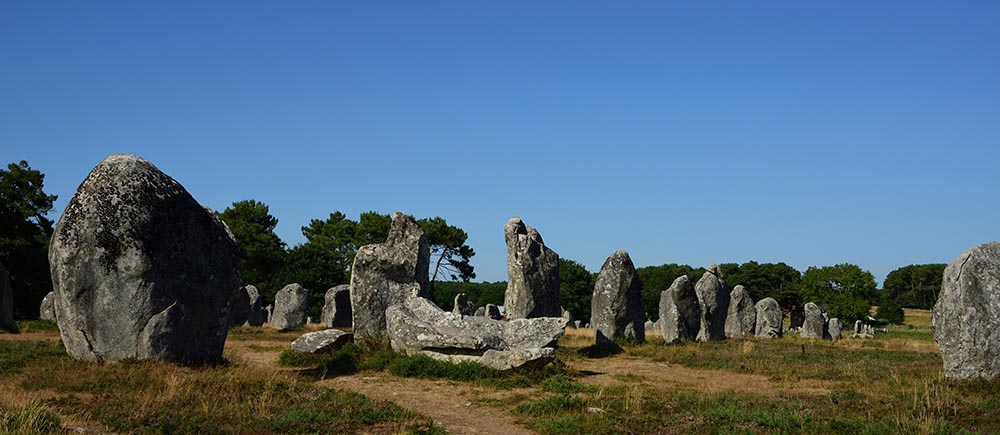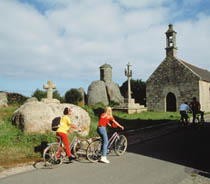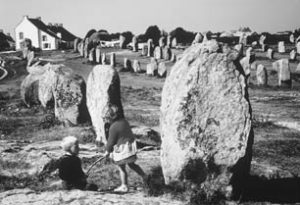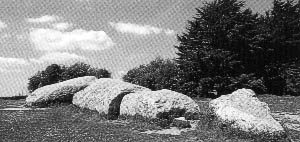
Near the coastal city of Carnac in the northwest of France are nearly 3,000 standing stones erected approximately 4,500 years ago
by Robert Scheer
 Carnac in Brittany, like its namesake in Egypt, is rich with ancient mysteries. It was once a major focal point for Celtic power and influence. Like Tara in Ireland, Carnac was a spiritual center for religious celebrations, tribal gatherings and astronomical observations.
Carnac in Brittany, like its namesake in Egypt, is rich with ancient mysteries. It was once a major focal point for Celtic power and influence. Like Tara in Ireland, Carnac was a spiritual center for religious celebrations, tribal gatherings and astronomical observations.
The Celtic pagan religion was so strong in Brittany that the full forces of Christianity were needed to convert it to the “new” religion. That is why this area of France has so many saints, literally thousands of them, although only a few are officially recognized by the church of Rome. A surprisingly large number of Breton saints are legendary for having slain dragons. Saint Sampson is said to have vanquished three of them. It is likely these mythical monsters were actually pagan cults which Sampson and his colleagues put to the sword.
Pagan worship was not actually destroyed by Christianity, but rather was overshadowed by it. Although some megaliths were knocked down or removed, others had crosses added to the top of them. Christian chapels were built over pagan holy wells and springs. Breton saints acquired the powers of the pagan deities they replaced. For example, in the chapel at Edern in Finistere, a depiction of Saint Edern riding a stag bears a strong resemblance to Cernunnos, the pagan god with antlers. In the Chapelle des Sept-Saints at Vieux-Marche’, the south aisle is built upon a prehistoric dolmen. Even though the names may have changed, the same healing powers which ancient Bretons discovered in a few of their wells and springs can still be found.
Folk traditions in Brittany, as in Ireland and Cornwall, are rich with legends about magical fairies, mermaids and other spirits. There are as many mysteries surrounding the menhirs of Carnac as there are about Stonehenge. Even King Arthur and Merlin appear in Breton folklore.
Near Pontivy in central Brittany is the picturesque town of Saint-Nicolas-des-Eaux, where you will find a sacred fountain dedicated to Saint Nicodemus. It is said that if you dip a child in the water, or soak its clothing, the child will be strong and safe from illnesses. Saint-Meriadec’s fountain in Pontivy was believed to be able to cure deafness.
Bretons say rituals are required for some healing waters to work. Women can enhance their fertility at a spring in Edern if they drop three pins into the water and then sprinkle it onto their stomach and breasts. To cure problems with breast-feeding, visit the well of Notre-Dame-des-Trois-Fountaines in Briec, drink some water from the spring-fed basin, wash your breasts in it, and then empty the basin. As it is refilled from the spring, your breasts will fill up with milk!
As in Cornwall, Breton wishing wells are said to work best if you drop a pin into them. If the pin floats, your wish will come true. Pins have other functions at some sites. At the Northern tip of Brittany in Ploumanac’h is the seaside oratory of Saint Guirec. If a girl puts a pin into the statue’s nose and it doesn’t fall out, then she will soon be married.
The belief in the power of holy water was so strong that, in 658, the Council at Nantes condemned the worship of fountains. Thirteen-hundred years later, the mysteries of fountains, springs and wells continue to intrigue us.
Nearly 3,000 Standing Stones
The eminent scholar Dr. Walter Y. Evans-Wentz, in his 1911 book Fairy-Faith in Celtic Countries, says that Carnac is one of the greatest places in Europe where the magnetic and “even more subtle forces” of psychic energies are powerful and tangible to sensitive individuals. A short boat trip from Carnac, on the island of Gavrinis, is a cairn and tomb said to be the finest prehistoric monument in the world. Evans-Wentz saw many similarities between the Gavrinis Tumulus and the Newgrange passage-tomb in Ireland’s Tara-Boyne area. He believed they were built by the same race of people. Gavrinis and Newgrange were both used for religious ceremonies and both are oriented toward the rising sun. Ornate carving on a threshold stone in Garvinis is remarkably similar to that on the lintel stone above the entrance to Newgrange. Evans-Wentz felt it was reasonable to suppose these ancient sites, along with the Great Pyramid in Egypt, were royal spirit-temples used in an ancient cult of ancestor worship which included funerals and rites of initiation.
Carnac
 A 15 mile stretch along the south coast of Brittany is known as the Cote des Megalithes. A staggering number of ancient stones can be found scattered across these moors and fields, with the resort city of Carnac in the centre. There are actually three sets of rows of standing stones, known as alignments, north of the city. Two of these, Menec and Kermario, have been fenced off. You can still wander among the 579 menhirs in the easternmost, Kerlescan alignment. Menec has 1,099 menhirs in 12 rows, each over a quarter of a mile long. There is a cromlech at each end of the alignment. At Kermario, with 999 stones, there is a viewing platform at the west end, as well as a shop with a good selection of books in English. The entire area, known as Les Alignements de Kerzerho, covers an area about 300 feet wide and two miles long.
A 15 mile stretch along the south coast of Brittany is known as the Cote des Megalithes. A staggering number of ancient stones can be found scattered across these moors and fields, with the resort city of Carnac in the centre. There are actually three sets of rows of standing stones, known as alignments, north of the city. Two of these, Menec and Kermario, have been fenced off. You can still wander among the 579 menhirs in the easternmost, Kerlescan alignment. Menec has 1,099 menhirs in 12 rows, each over a quarter of a mile long. There is a cromlech at each end of the alignment. At Kermario, with 999 stones, there is a viewing platform at the west end, as well as a shop with a good selection of books in English. The entire area, known as Les Alignements de Kerzerho, covers an area about 300 feet wide and two miles long.
There are 30 prehistoric sites near Carnac, all mapped out in the official guide book available from the local tourist office. Besides the alignments, three of the most interesting sites are the Saint-Michel Tumulus, an excavated tomb 360 feet long by 36 feet high; Tumulus de Kercado, a tomb with a menhir on top; and the Dolmen de Crucuno, alongside which a farm-house has been built.
Before you see the ancient sites, you may want to visit the Musee de Prehistoire in Carnac-Ville, where English guidebooks are available to describe the exhibits. The museum was founded in 1882 by James Miln, a Scotsman who was fascinated by the mysterious stones of Carnac.
Locmariaquer
 Thirteen kilometers east of Carnac, at the tip of a peninsula, is another resort town that makes a good base for touring the Cote des Megalithes. Locmariaquer has four significant megalithic sites including the Great Menhir or Grand Menhir Brise, also known as Mener-Hroec. When it was intact, this 340-ton granite stone stood 98 feet tall. It was broken by lightning and now lies in five pieces, the largest of which is almost 40 feet long.
Thirteen kilometers east of Carnac, at the tip of a peninsula, is another resort town that makes a good base for touring the Cote des Megalithes. Locmariaquer has four significant megalithic sites including the Great Menhir or Grand Menhir Brise, also known as Mener-Hroec. When it was intact, this 340-ton granite stone stood 98 feet tall. It was broken by lightning and now lies in five pieces, the largest of which is almost 40 feet long.
Nearby is a very well-preserved dolmen known as the Table des Marchands or Merchants Table, with a 100-ton capstone covering a large chamber. The supporting stones are carved with stylized suns and ears of corn. The drama of these enormous stones is enhanced by their desolate moorland setting.
Also near Locmariaquer, on the sand dunes, is the Dolmen des Pierres Plates (dolmen of the flat stones), a tomb filled with decorated stones with its entrance facing the sea. Dolmen Mane-Rethual has been partially restored with concrete supports, and is located in a private back yard, concealed by hedges.
Four Site Pass Available
Anyone planning on visiting all four major megalithic sites can buy a pass that includes admission to the Table des Marchands, Great Menhir, Saint-Michel Tumulus and Carnac Museum of Prehistory.
Gavrinis
It is said that, if you can only visit one prehistoric site in Brittany, the megalithic tomb at Gavrinis is the one to choose. On an island in the Gulf of Morbihan, it is accessible by a 15-minute boat ride from Larmor-Baden. Gavrinis Tumulus is massive: 20-feet high and 165-feet in circumference. 29 upright stones lead through a passageway and into a large chamber, capped with a huge slab measuring 13-feet square. There are lavish carvings of serpents, shepherds’ crooks, trees, suns and chevron patterns. Three strange holes, almost like a pre-historic wine-rack, are cut into the rock of one of the chambers.
Dr. Evans-Wentz noticed that the outside edges of these holes have been worn smooth, as if they had been used for hundreds of years, proof that this chamber was used for on-going ceremonial purposes, and not simply sealed up as a tomb.
As you enter the narrow passage going into the inner chamber, you must step over two very prominent stone sills on the floor. Evans-Wentz believed that these are literally stumbling blocks used in initiation ceremonies, in which neophytes travel a symbolic journey across obstacles, to the inner chamber or Sanctum Sanctorum. Designs on the threshold of the inner chamber are remarkably similar to the spiral and chevron patterns carved on the lintel stone above the entrance to the Irish passage-tomb at Newgrange.
Vannes
Nineteen miles inland from Carnac, the very old, walled town of Vannes may be the prettiest and most interesting town in Brittany, with many wooden medieval buildings. Its archeological museum has a fine collection of prehistoric jewelry, weapons, tools and pottery found in Stone Age excavations nearby.
La Roche-aux-Fees
Near the centre of the eastern edge of Brittany, approximately 120 km. northeast of Carnac, is the largest megalithic monument in the region, and the second biggest one in France. La Roche-aux-Fees can be found about halfway between Rennes and Chateaubriant. It is a tumulus which was once covered with earth, but its 42 huge stones, the heaviest of which weighs 45 tons, are now above ground level, giving it the appearance of a great, multi-sectioned dolmen. Centuries ago, engaged couples would walk around the stones during a new moon while counting the stones. If they agreed upon the number of stones in the monument, their marriage would do well, but if their numbers were more than two stones apart, the relationship was doomed.
Other Breton Sites
In western Brittany, on the peninsula south of Brest, near the town of Crozon, is Lagatjar, with nearly 150 menhirs aligned like a miniature version of Carnac.
If you’re near the resort of Brignogan-Plages, you might want to try and discover why a menhir there is called the Miracle Stone. The answer could lie 8 miles inland in le Folgoet, a village rich with folk legends, with a folk museum in a 500 year-old manor house.
Finally, about 35 km. east of Vannes, near Rochefort-en-Terre, is the Parc de Prehistoire at Malansac. More of a theme park than an actual prehistoric site, this tourist attraction offers a recreation of Breton life between 25,000 and 2,000 BC. Children and adults may enjoy seeing how early Stone Age people made tools and shelters, and how later, Cro-Magnons hunted mammoths. There is also a demonstration of how large menhirs may have been moved great distances.
Legends Of Breton Menhirs
The ancient megaliths of Brittany are mysterious for two reasons. We do not know how prehistoric Bretons were able to move and place these massive stones weighing as much as 350 tons each, nor do we even know why. Centuries ago it was said that the Carnac alignments were stone tent pegs left behind by Roman soldiers. It is now believed they were built approximately 3,000 to 4,500 years ago. The French writer, Flaubert, was probably correct when he remarked that “Carnac has more rubbish written about it than it has standing stones.”
Further Information
For more information about the megaliths, menhirs and dolmens of Carnac and the Crozon Peninsula, contact the Morbihan Tourist Office:
Comite Departemental du Tourism Morbihan,
Hotel du Department, BP 400,
56009 Vannes Cedex, FRANCE
Tel: (011.33.2) 97.54.06.56
Or visit the Brittany Tourism website.
Photos courtesy of French Tourist Office.
Robert Scheer is a travel writer and editor of New Age Travel.
This article was published originally in the October/November, 1997 issue of Power Trips magazine.